

On the 7th of January 1610 an Italian astronomer and physicist by the name of Galileo Galilei used a new instrument (originally a child’s toy) called a telescope to observe Jupiter. On this day he discovered small bodies around Jupiter which he initially believed to be stars. It wasn’t until later after observing them orbiting the planet that he determined they were some of its moons. By the 11th of January Galileo had discovered four large moons in total which are today known as the Galilean moons.
Group/Moon |
Diameter |
Distance from Jupiter |
Inner Group (Metis, Andrastea, Almalthea & Thebe) |
Less than 200km |
Less than 200,000 km |
Galilean |
See above |
See above |
Themisto |
8km |
7,392,000km |
Himalia group |
Mostly <100km |
11-12 million km |
Ananke Group |
Mostly <30km |
21 million km |
Carme Group |
Mostly <5km |
23 million km |
Pasiphaë |
Very small moons |
Over 23 million km |
Europa is an ice giant. It has an iron rich core and a layer of rock in its centre then an ocean that covers the entire moon and contains twice the amount of water than we have on Earth and finally an icy crust protecting the ocean. This makes Europa a great candidate for life beyond our planet. NASA’s Galileo mission found evidence of the oceans and some of the chemicals present on Europa (and the other moons) but new data collected from the Keck II telescope in Hawaii has provided further evidence.
This is the largest moon in the entire solar system with a radius of 2,631km (1,635mi)followed closely by Saturn’s giant moon Titan (with a radius of 2,575km or 1,600mi). Ganymede is even larger than Mercury (with a radius of 2,440km or 1,516mi). It also has its own independently generated magnetosphere which appears to be a unique property for a moon in our solar system.Ganymede has an iron rich core and is also believed to have an ocean deep below its crust. Ganymede is the third furthest moon from Jupiter.
The closest moon to Jupiter in the Galilean series Io is the most volcanic place in the solar system with constant eruptions and a surface that is coated in lava flows and sulphur. The powerful gravitational pull of Jupiter causes tides on Io’s surface with waves of rock up to 100 meters (300 feet) high. Io has a core, a mantle and a solid rock surface but unlike the rest of the Galilean moons it has no ocean buried within its layers.
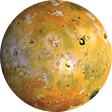
In an article released on NASA’s site on the 4th of April 2013explaining the importance of the new data and a paper led by NASA researchers. The lead Author of the paper Mr Kevin Hand explains “Life as we know it needs liquid water, elements like carbon, nitrogen, phosphorus and sulphur and it needs some form of chemical or light energy to get the business of life done. Europa has the liquid water and elements and we think that compounds like peroxide might be an important part of the energy requirement. The availability of oxidants like peroxide on Earth was a crucial part of the rise of complex, multi-cellular life”.1
The new data provided by the study shows that the peroxide concentration levels are much higher than previously thought and cover a hemisphere of the moon making it likely that this peroxide can make its way through into the ocean.
Ref:
1. http://www.nasa.gov/topics/solarsystem/features/europa20130404.html
Satellite |
Distance From Jupiter |
Mean Radius |
Orbital Period (Earth Days) |
Density (g/cm3) |
Io |
422,00km |
1,821.6km |
1.769 |
3.528 |
Europa |
671,000km |
1,560.8km |
3.551 |
3.013 |
Ganymede |
1,070,000km |
2,631km |
7.155 |
1.942 |
Callisto |
1,883,000km |
2,410km |
16.689 |
1.834 |
Th
Callisto is the outermost moon of the Galilean group of moons and the second largest of Jupiter’s satellites. Callisto too has an ocean buried deep beneath its crust and its layers are made up of a mixture of ice and rock. The surface of Callisto is heavily cratered which can be seen from a distance, although active landslides are thought to mask these craters if viewed from Callisto’s surface.
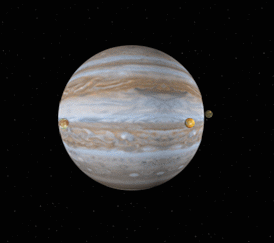
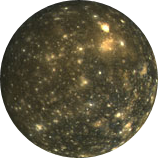
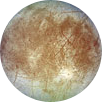


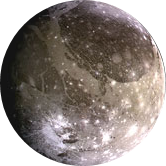

When Galileo’s discovery was made public in a book called ‘Sidereus Nunciut’ it made Galileo famous as well as changing the view of the cosmos dramatically. Classical astronomy suggested that Earth was the centre of the universe and everything revolved around us. This idea was also endorsed by the church as this helped imply the divinity of Earth and god’s creation the life upon it (mainly humans). Copernicus had previously suggested that Earth actually evolved around the sun and the moon around Earth but many people did not except this ‘Theory’. Now Galileo too provided evidence to contradict the classical and religious idea of our importance in the universe.
For this heresy Galileo was locked up for many and ordered to renounce what he had published in his book. Although Galileo had refused at first, the threat of being put to death by the church made him concede to their demands. But the truth cannot be silenced forever.
Initially the Galileon moons were known collectively as ‘Medicean Stars" a name given to them by Galileo himself and individually they were simply numbered 1 to four with 1 being the closest satellite to Jupiter. This proved sufficient until more moons were discovered, some of which lay closer than those previously found and things became confusing. A German astronomer Simon Marius (with help from Johannes Kepler) had previously suggested naming the moons after other characters from Roman mythology connected to Jupiter but this never took off at the time. The names Marius suggested were adopted much later and are the names we use today.

